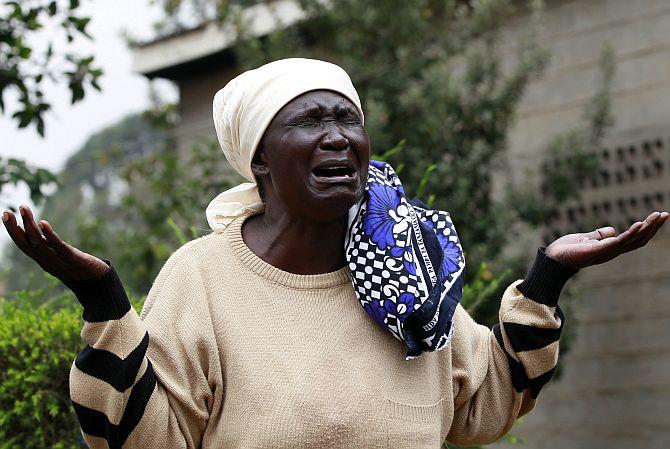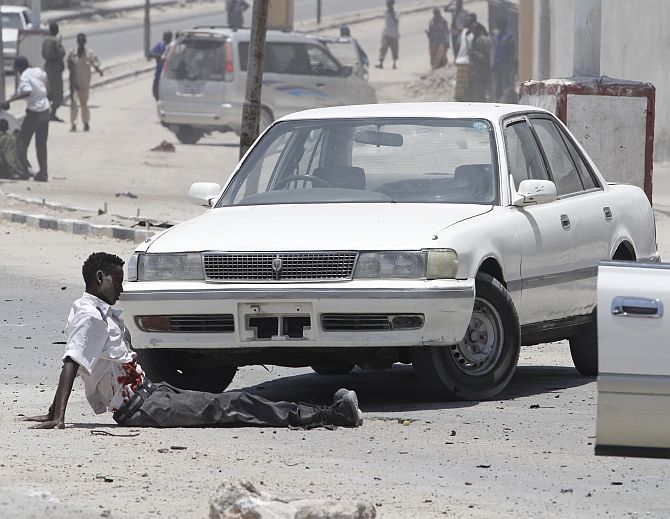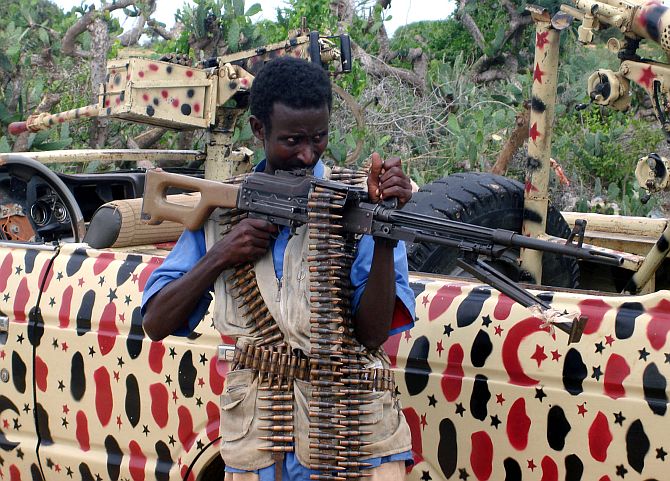 | « Back to article | Print this article |
Terror trail: Africa's deadly 5
The four-day bloody terror siege at an upscale mall in Kenyan capital Nairobi pointed to the extent to which the menace had spread its wings in Africa.
With reports suggesting that British and American citizens were among the gunmen who massacred 64 people inside the Westgate Mall, the dangerous evolution of outfits like Al Shabaab, Boko Haram and Al Qaeda in the Islamic Maghreb is finally being noticed.
Reportedly, these groups now have the resources to reconnoiter and launch complex attacks against places far from their strongholds, using a network of camps and intermediaries throughout the desert.
Let’s take a look at some of the major terror outfits operating in African continent
Click on NEXT to read further...
Terror trail: Africa's deadly 5
Boko Haram, which means “Western education is forbidden,” is a Nigeria-based terrorist organization that seeks to overthrow the current Nigerian government and replace it with a regime based on Islamic law.
The group has existed in various forms since the late 1990s.
There are reported communications, training, and weapons links between Boko Haram, Al Qaeda in the Lands of the Islamic Maghreb (AQIM), Al Shabaab, and Al Qaeda in the Arabian Peninsula, which may strengthen Boko Haram’s capacity to conduct terrorist attacks.
The group set off its first vehicle-borne improvised explosive device (IED) in June 2011, and has increasingly utilized IEDs in attacks against soft targets.
Boko Haram’s August 26, 2011 vehicle-bomb attack on the United Nations headquarters in Abuja, Nigeria marked the group’s first lethal operation against Western interests. At least 23 people were killed, and 80 more were injured, in the attack.
Click on NEXT to read further...
Terror trail: Africa's deadly 5
Al Qaeda in the Islamic Maghreb, previously known as the Salafist Group for Preaching and Combat, has conducted dozens of terrorist attacks in the northwest Africa region.
AQIM has claimed responsibility for suicide bombings, kidnappings of Westerners, assassinations, and improvised explosive device attacks.
The group conducted two simultaneous suicide operations in December 2007, attacking a United Nations programme headquarters and the Algerian Constitutional Council, killing 42 people and wounding 158 others.
In September 2012, AQIM encouraged members to threaten US embassies and kill US ambassadors.
The outfit announced its official alliance to Al Qaeda in September 2006, and has since reaffirmed its intention to attack Western targets.
Click on NEXT to go further...
Terror trail: Africa's deadly 5
Al Shabaab was the militant wing of the Somali Council of Islamic Courts that took over most of southern Somalia in the second half of 2006.
It has continued its violent insurgency in southern and central Somalia.
The group has claimed responsibility for many bombings -- including various types of suicide attacks -- in Mogadishu and in central and northern Somalia, typically targeting Somali government officials and perceived allies of the Transitional Federal Government of Somalia.
Al Shabaab was likely responsible for a wave of five coordinated suicide car bombings in October 2008 that simultaneously hit targets in two cities in northern Somalia, killing at least 26 people and injuring 29 others. Al-Shabaab was responsible for the twin suicide bombings in Kampala, Uganda, on July 11, 2010, which killed more than 70 people, including one American.
The group is responsible for the assassination of Somali peace activists, international aid workers, numerous civil society figures, and journalists.
In February 2012, Al Shabaab and Al Qaeda announced their formal alliance.
Click on NEXT to read further...
Terror trail: Africa's deadly 5
Ansar al-Dine is an organization operating in Mali which cooperates closely with Al Qaeda in the Islamic Maghreb.
The outfit was created in late 2011 after its leader Iyad ag Ghali failed in an attempt to take over a secular Tuareg organization due to his extremist views. It has received support from AQIM since its inception in late 2011, and continues to maintain close ties to the group.
The outfit has received backing from AQIM in its fight against Malian and French forces, most notably in the capture of the Malian towns of Agulhok, Tessalit, Kidal, Gao, and Timbuktu, between January and April 2012.
In AAD’s March 2012 attack against the town of Aguelhok, the group executed 82 Malian soldiers and kidnapped 30 more.
Before the French intervention in January 2013, Malian citizens in towns under AAD’s control who did not comply with AAD’s laws faced harassment, torture, or execution.
Click on NEXT to read further...
Terror trail: Africa's deadly 5
The Lord's Resistance Army has been active since 1986, making it one of Africa’s oldest, most violent, and persistent armed groups. The LRA was formed in northern Uganda to fight against the government, and operated there from 1986 to 2006. At the height of the conflict, nearly two million people in northern Uganda were displaced.
Under increasing pressure, LRA’s leader Joseph Kony ordered the LRA to withdraw completely from Uganda in 2005 and 2006 and move west into the border region of the Democratic Republic of the Congo (DRC), the Central African Republic (CAR), and what would become the Republic of South Sudan. The LRA has continued to operate in this border region to date.
A 2006 study funded by UNICEF estimated that at least 66,000 children and youth had been abducted by the LRA between 1986 and 2005. According to that study, most of these children were only held for a brief period of time and then released or escaped, but others were forced to become child soldiers or sex slaves and commit unspeakable acts.
As a result of military pressure and defections, the LRA’s core fighters have been reduced to an estimated 150-200, in addition to an unknown number of accompanying abductees, women and children. However, the LRA retains the capacity to cast a wide shadow across the region because of its brutality and the fear it arouses in local populations.
Click on NEXT to go further...
TOP photo features you missed last week
Click on MORE to see another PHOTO features...






